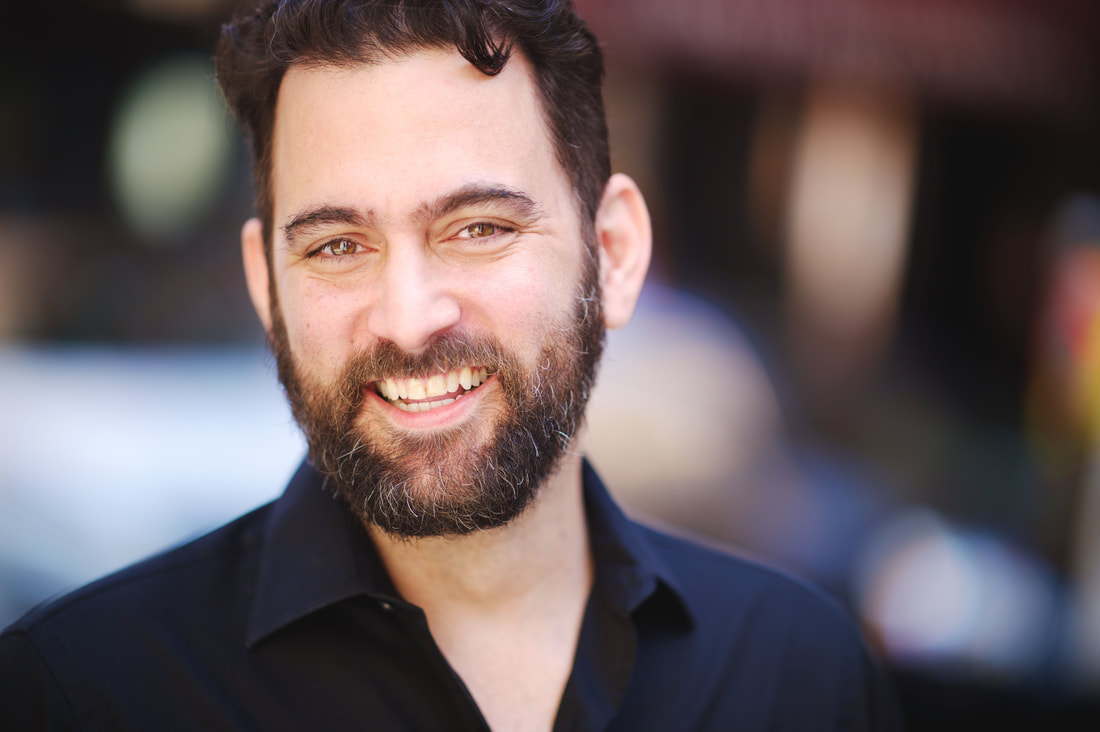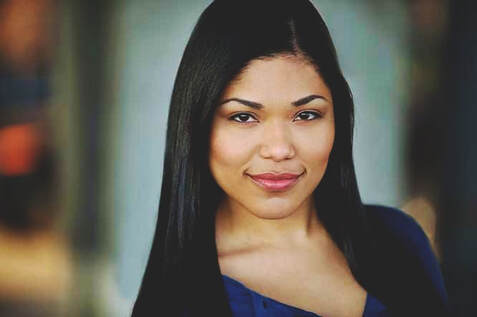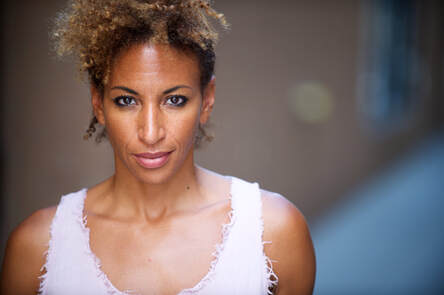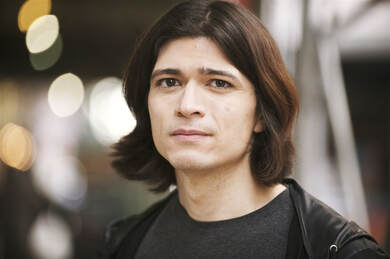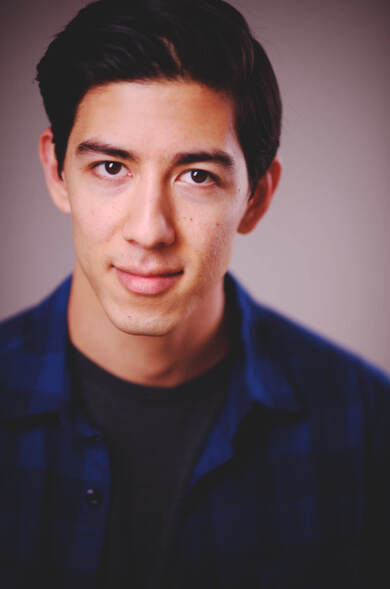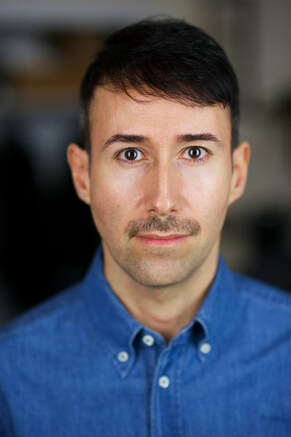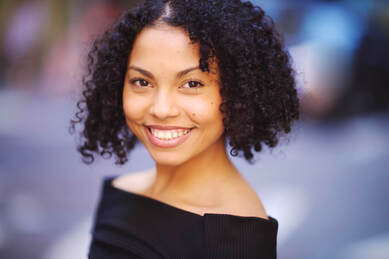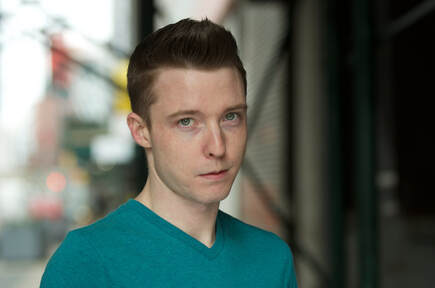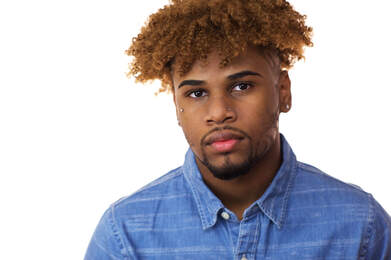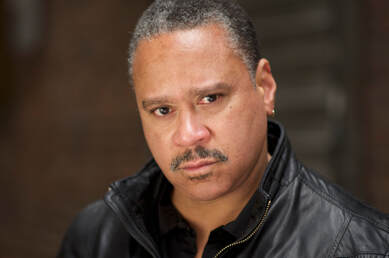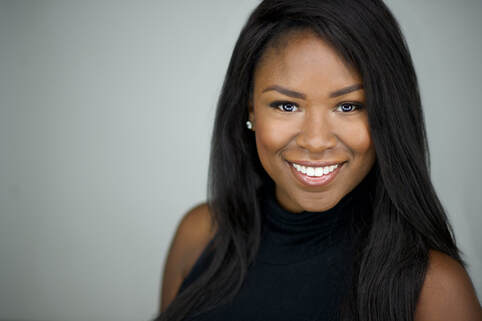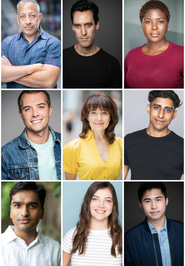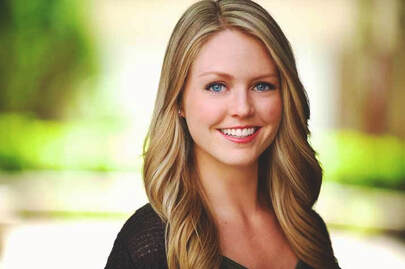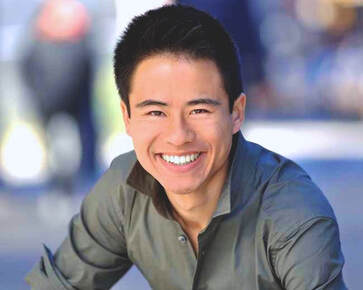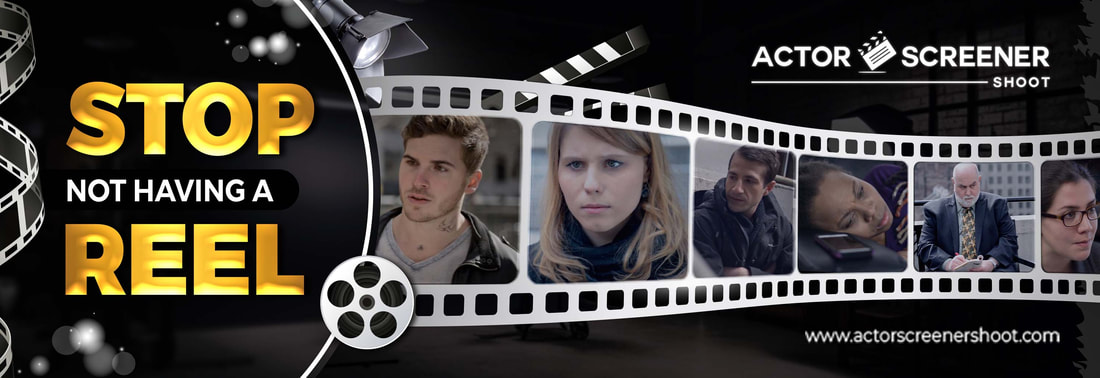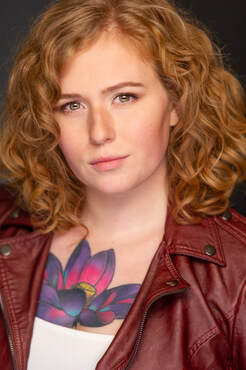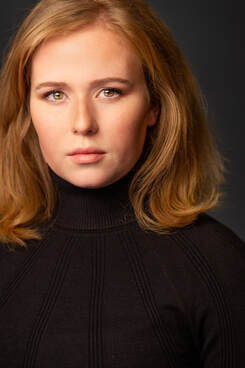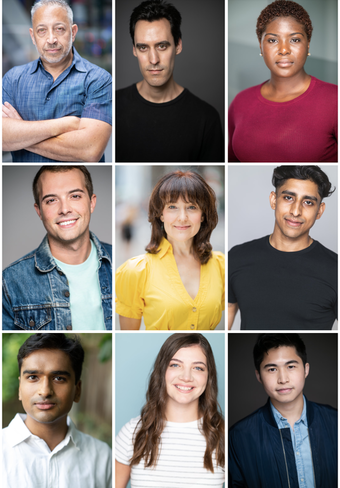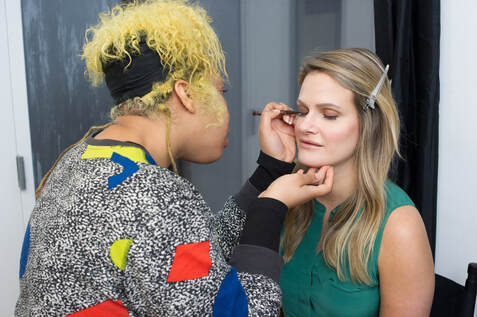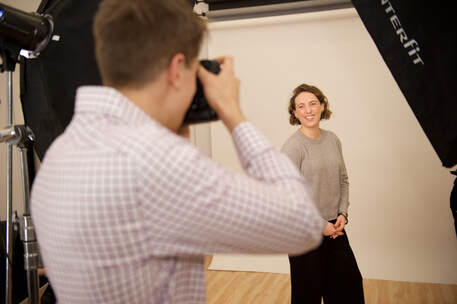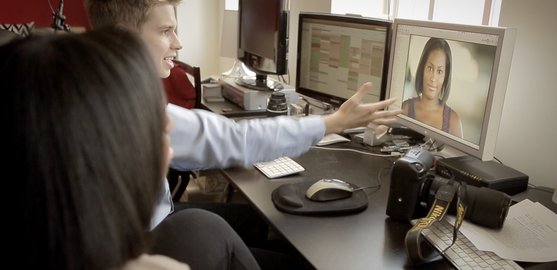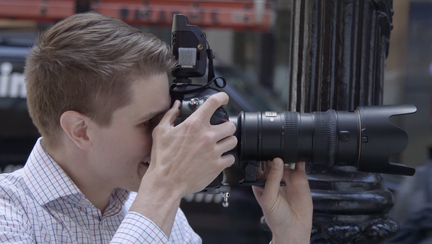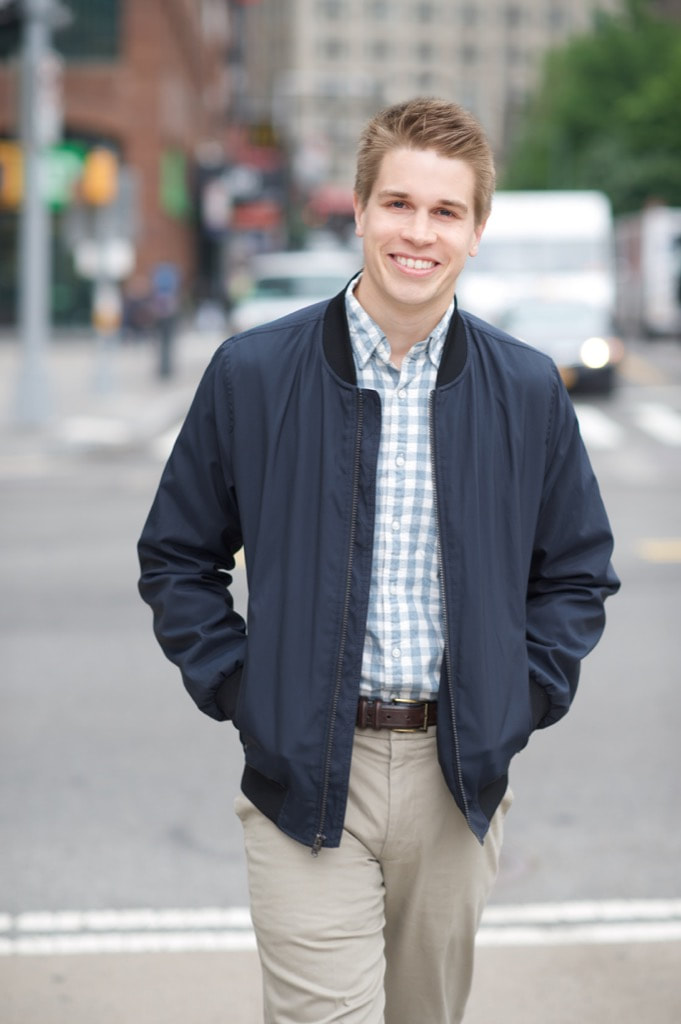|
Here's some of what's covered in this Ultimate Guide to Actor Headshots:
Ready to get started? Actor Headshots: The Ultimate Guide
Actor headshots are CRITICAL because they show casting directors what you look like.
Fair or unfair, most actors get hired because of how they look, not just their talents. For instance, if a production needs an Asian person, they'll never consider you if you're white. Acting is probably the only industry where you can legitimately discriminate against people based on what they look like (without getting into trouble). Planning an upcoming shoot? Download our free Actor Headshot Checklist.
|
|
1 of 8: Why it's good:
Her expression is very natural – there is no tension in her face. This image has been only lightly photoshopped so you can still see some imperfections on the face, which makes it look real. She looks confident, relaxed and we get a sense that she's an experienced actor. She looks confident in herself, which tells casting directors that she can act. |
2 of 8: Why it's not so good:
He looks uncomfortable and has a weird posture – his head is tilted at an odd angle. The background is distracting with the lights on the left side and the harsh lines on the right. Even though it has not been retouched, that's not a problem here – the biggest problem is that his expression makes him look inexperienced, like he isn't a skilled actor |
|
3 of 8: Why it's good:
It's un-retouched, so he looks very natural in the shot. Casting directors LOVE un-retouched (or minimally retouched) headshots because it shows them what you really look like. Now, even though he has a serious expression, there is no tension in his face and he looks confident. His hair is cropped off slightly at the top, but that's expected as casting directors know the top of the head is there. The checked shirt could be considered distracting by some, but because it's so dark it doesn't draw the eye. |
4 of 8: Why it's not so good:
All the technical aspect of this shot are good! HOWEVER, his expression looks a bit crazy/confused, making him look like he "doesn't know what he's doing." The expression is probably costing this actor TONS of missed opportunities. We actually created a free guide called "Upgrade Your $400 Headshot to a $1,500 One" that shows you how to direct YOURSELF into great expressions – even if your photographer is unable to do it. |
|
5 of 8: Why it's good:
Her expression is extremely natural, the lighting is very soft, and the background is not distracting. She truly looks confident and relaxed in the photo, as though she's a bright, fun, and friendly actress. |
6 of 8: Why it's not so good:
His expression looks a bit confused and his head is tilted in a slightly unnatural way, making him look awkward. Also, the background is distracting with the lines cutting across; they draw attention away from his face. |
|
7 of 8: Why it's good:
He looks very relaxed with no mouth tension. His shirt could be considered distracting because of the slight pattern, but it's not very noticeable so it still works. The white background creates a nice contrast so he pops off the image instead of blending in against a dull backdrop. That contrast is what makes the image "pop," and is what captures the eye of casting directors. |
8 of 8: Why it's not so good:
In this photo, the background and lighting are fine. There is a bit of shine on his forehead which could have been minimized, but the biggest issue is that he doesn't seem comfortable or relaxed in the shot. His eyes give it away. He looks like he's "trying too hard" to look intense, which looks unnatural and tells casting directors he's not a good actor (even if he is!). Can you see it? |
What Should Actor Headshots Look Like?
To put it simply, a theatre headshot needs to show you clearly, have a good expression, and look like you spent some money on it. And to really stand out, it needs to show a clear Type (if you're not clear on your Types, here's a 10-Minute Exercise to Find Your Type).
Low budget, unprofessional headshots tend to perform poorly because casting directors (who look at thousands of headshots a week) can tell right away if you spent money on it and shot with a dedicated headshot photographer.
Their thinking goes, "If an actor has a low-budget headshot (one that doesn't look expensive), they probably don't take their career seriously and won't be worth bringing in."
A professional actor headshot should at minimum be shot with the following pieces of equipment:
Low budget, unprofessional headshots tend to perform poorly because casting directors (who look at thousands of headshots a week) can tell right away if you spent money on it and shot with a dedicated headshot photographer.
Their thinking goes, "If an actor has a low-budget headshot (one that doesn't look expensive), they probably don't take their career seriously and won't be worth bringing in."
A professional actor headshot should at minimum be shot with the following pieces of equipment:
- Professional dSLR camera or mirrorless camera. Here's a dSLR I recommend and a mirrorless camera I recommend.
- Professional lighting, either using a window or soft box. Here's an affordable soft box I recommend.
- Professional, non-distracting backdrop. Either outdoors with a lens that completely blurs the background or indoors using a collapsible 5x7 backdrop or seamless paper backdrop.
A few years ago, there were some differences between NYC headshots and LA headshots, but these days there are not many differences at all.
Here are a few important elements for a great actor or actress headshot:
- Indoor vs. Outdoor: Actor headshots can be shot indoors or outdoors – it won't make much of a difference to casting directors. Indoor headshots are usually done with studio lighting and have either blurry backgrounds or flat backdrops (gray, white, or black are most common, but some include colored backdrops). Outdoor headshots should have the background blurred so it's not distracting.
- Smiling vs. Serious: Ideally you should do some of both. Don't worry if your teeth are a bit crooked or slightly yellow because retouching can fix that. If you wear braces, you should still take a smiling shot because casting directors need to know (related: Acting With Braces & How to Book More Work). Smiling shots are called "commercial headshots" and are great for submissions to comedic and friendly roles, or for TV commercials. Serious shots are called "legit shots" and cover a range of expressions from confident to sneaky. They should be used when applying to more serious roles, such as dramatic TV shows and films.
- Specific vs. Generalized: Most actors think they should do a generalized theatre headshot that can be submitted to a wide variety of auditions. This is a huge mistake. It's WAY more effective to shoot a few different specific Type headshots and then submit the most relevant headshot to each audition. Example: if you're submitting for a role to play a psychologist, you'd want to use a completely different headshot than if you're submitting to play a blue-collar construction worker.
- Framing: The framing of your headshot should be at least waist up, but more ideally it should be taken closer, from chest up. Further out than that would be considered a body shot which, although useful for certain things like websites and social media pages, is unlikely to be noticed by a casting director looking through hundreds of shots on their screen. Remember, they're looking at many photos at once at a very small size, and when your photo is shot closer, they can see your face better since it's so small.
-
Horizontal vs. Vertical: In general, vertical headshots are easier to use and most casting directors prefer them. From about 2005-2012, horizontal headshots were very popular, but they've largely been fading since most online casting websites prefer vertical shots to be uploaded. Unless your outfit is not conducive to a vertical shot (meaning you can see cleavage or something else that's distracting below your neck), you should take your headshots vertically.
- Note: for the sake of this blog post, we mostly used horizontal headshots just because they worked better for the layout of the page.
-
Natural vs. Studio Lighting: Some actors prefer natural light and some prefer studio light, but most casting directors don't care as long as they can see your face clearly. If the photographer uses specialized lighting to alter the shape of your face (making you thinner, for example), that's a BIG problem. Casting directors hate when actors look different in real life than they do in their headshot, so be sure to avoid that.
- Related: Headshot Lighting: The Ultimate Guide
-
Background: The background should not be distracting. If you're shooting with real life (as opposed to a flat backdrop) in the background, make sure it's extremely blurred out so you can't tell what's behind you. The sharper the background, the less professional and more distracting your headshot will look. You should also "pop" off the background, meaning if the background is really dark, you should be wearing a lighter color (or the photographer should light you in a specific way) so that you don't blend in with the background.
- If interested, you can download our bonus resource: The Ultimate Guide to Headshot Backdrops for Actors.
- Props: Avoid props and keep your hands out of the shot, unless it's being taken from the waist up. For true actor headshots (taken chest up), your hands should never be in the shot. The only "props" you can have would be glasses if you normally wear them. Keep jewelry and anything else that's not YOU out of the shot.
- Cropping and Dimensions: Actor headshots are usually printed on 8" by 10" paper, so they should be shot with a high-resolution camera so they appear sharp when printed big. It's common to crop off the tip of the hair in actor headshots, so don't worry if your photographer does this. We'll discuss printing in more detail later.
- Color vs. Black & White: Black and white was done in the past when it was more expensive to shoot and print photos in color, but nowadays since everything is digital, color is the way to go. Casting directors hate getting black and white headshots for theatre or screen because it's impossible to know the color of your hair or eyes.
- Capture Your Type: An effective headshot will tell a casting director right away how to place you. Are you good at playing detective roles? Young mothers? Business CEO roles? If your headshot is unclear or you don't know what your Types are, casting directors will be significantly less likely to call you in for the audition.
Planning an upcoming shoot? Download our free Actor Headshot Checklist.
Find Your Type... in Just 10 Minutes
Download our Popular "Find Your Types" Exercise
The clearer you are on your Types, the more auditions you'll get with your headshots. This guide shows you how to shortcut the process of finding your Type from months to minutes.
Here's what's included:
Here's what's included:
|
Downloaded by over 19,500 actors so far.
"LOVED this!!! THANK YOU! Types I've narrowed down to - Edgy Business Pro, Punky Mom, Sexy Rockstar, Love Interest, Leading Lady, Sexy Powerhouse Boss, and CEO. Fun and SO HELPFUL! Scheduled another photo shoot now to really capture these characters discovered!! Honestly, THANK YOU, this tool has been invaluable for me!!"
-Kate J.
How a Headshot Session Works
Actor headshots are nothing to be afraid of! Sessions are very simple and straightforward (as long as you pick a good photographer).
Basically what happens is you'll contact some different photographers, find someone who's right for you, and schedule a time for your shoot.
You'll show up at their studio (or predetermined location), and they will guide you through the process where they tell you where to stand, what to do, etc. Keep in mind that better photographers will be much more specific with directions and guiding you (whereas cheaper photographers will put more of the work on you).
In our sessions at City Headshots, we provide TONS of hyper specific direction to ensure every actor we work with looks their best on camera. We've been shooting since 2009. Check out our actor & theatre headshot work here.
What Do Actor & Actress Headshots Cost?
In general, you can expect to pay anywhere from $200 to $1,000 for them, depending on where you are in the country and how many looks/outfits you need.
Avoid spending less than $200 because most photographers that charge super cheap rates do so because they don't do great work.
The more expensive the photographer is (in general), the better your experience will be and the more usable shots you'll get.
That being said, avoid spending more than $1,000 because once you get to such levels, you'll find that you're just paying for the photographer's name (some photographers are really great at networking or have just been in the industry for decades).
Learn more about headshot cost breakdown here.
Avoid spending less than $200 because most photographers that charge super cheap rates do so because they don't do great work.
The more expensive the photographer is (in general), the better your experience will be and the more usable shots you'll get.
That being said, avoid spending more than $1,000 because once you get to such levels, you'll find that you're just paying for the photographer's name (some photographers are really great at networking or have just been in the industry for decades).
Learn more about headshot cost breakdown here.
Need New Actor Headshots?
The Process of Shooting Headshots
Headshot sessions usually consist of the following steps:
- Pre-Shoot Discussion: When you first arrive at the studio, the photographer will probably ask some questions about your goals and help figure out which outfits you should wear. They'll also explain what will happen during the shoot.
- The Shoot: Usually the shoot lasts anywhere from 45 minutes to a few hours, depending on how many "looks" you're doing (more on "looks" soon). The photographer will tell you where to stand and what to do, and will say certain things to try to get you to give certain expressions. All you need to worry about is doing what the photographer says, and asking questions when you're not sure. They'll usually take a lot of shots quickly (like 5-10 images per burst) so they can capture subtle expression changes on your face. Good photographers are usually willing to show you the pictures throughout the shoot so you get an idea of what they're looking like so you can make changes if you're not liking certain things.
- After the Shoot: Some photographers will sit down with you after the session to look at the photos together, and others will just send the images to you via an online link. They usually delete any unusable shots and do basic color adjustments before sending the shots to you for review. In some cases, you'll get access to the high-quality, full-size images, and in other cases the photographer will only send you small preview files with watermarks on them. Either way, your job at this point is to choose which pictures you like best and let the photographer know.
- Retouching and Printing: Most photographers include retouching in their packages, meaning they'll fix blemishes, whiten teeth, etc. You just need to let them know which shots you want retouched, and then they'll usually email them back when finished so you can get them printed and start using them (more on that soon).
How to Prepare for Your Shoot
In order to get great actor or actresses headshots, there are a few key things to keep in mind before your shoot:
Planning an upcoming shoot? Download our free Actor Headshot Checklist.
- The right mindset: Go in expecting to get a great shot AND have a fun time, and don't be overly obsessed with capturing the PERFECT shot. This means you should have an open mind – be prepared to try different expressions and body positions. If you're obsessed with only capturing one type of shot, it can make it difficult for you to relax enough to get good expressions.
- A great headshot should look like you: Wanting to look thinner or more glamorous in your headshot than you do in real life might sound good on the surface, but it's a mistake. Casting directors hate when you look different in real life than you do in your headshot, and they'll almost never book you for the role because you've wasted their time – they wanted you for how you looked in the photo! This applies even if your audition was perfect and you memorized every single line. Asking your photographer to use special lighting setups to change how you look will cost you in the long run, so be confident in who you are and what you look like! There is a place for everyone in this industry.
- Bring your clothing and anything needed for the shoot: Headshot photographers almost never carry clothing in their studio, so be sure to plan out what you're going to wear and bring in more than you think you'll need. Also, if you're planning to do different hairstyles or a scruffy and clean-shaven look, don't forget to bring the tools required!
- Plan to arrive early: Arriving late is one of the biggest pet peeves of headshot photographers, and if you're more than a couple minutes late to your shoot, it can eat into your session time. To avoid feeling rushed, be sure to arrive at least 5-10 minutes early (meaning plan ahead for possible traffic delays).
Planning an upcoming shoot? Download our free Actor Headshot Checklist.
What are "Looks" and How Many Should I Do?
The following two shots are of the same actress, but with different "looks." Her hairstyle and outfit are different, as is her expression. Although she could have done two different backdrops (one outdoor and one indoor, perhaps), these shots wound up being taken on the same dark gray backdrop.
- What are "Looks"? Looks are considered outfits + backdrops. So if you wanted three different "looks," that means you'd be getting three different kinds of shots. One look might be a business professional shot, taken outdoors with the street blurred out behind you. Another might be where you look like a gang member, wearing a leather jacket with a dark alleyway blurred out behind you. The final look might be shot on a white backdrop, where you're wearing a dark blue t-shirt, to be used as a "commercial" headshot. For each look, you'll usually do a variety of poses and expressions, so you might walk away with 300 shots altogether – 100 pictures taken for each "look."
- How Long Should My Shoot Be? Depending on the skill level of the photographer, most shoots take anywhere from 20 minutes to an hour per look. The most skilled photographers usually need less time, so a 3-Look shoot might only take an hour or so, whereas if you're working with a newer photographer it could take up to three hours to capture good expressions for each "look."
- How Many Shots or "Looks" Do I Need? Most actors should do at least two looks, aiming for one "commercial" and one "legit" shot at minimum. This means one bright, smiley, fun headshot, and one darker, moodier shot. The commercial shot can be used for submitting yourself to perform in commercials and bright, fun scenes, and the darker "legit" shot can be used for more serious roles in dramas, etc.
Remember – your photographer might actually shoot 100, 200, or 300 shots, but your goal is only to pick your top few favorites out of the entire bunch. No one will ever see all the other pictures you did.
How Do I Capture My "Type" in Headshots?
You may have heard of the word Type before.
Type essentially means what you look like to other people. Do you look like a typical cop? A mom? A grandmother? A gangster?
It's unfortunate, but in the acting industry, casting directors often look for stereotyped versions of characters that would seem "believable" to the audience.
For example, they wouldn't often hire a 22 year old woman to play a psychologist – most people would assume she'd look too young.
This means you should figure out your Type(s) BEFORE you do your headshots, because the more specific you are, the more auditions you'll get. You should aim to shoot specific "looks" for each of the Type(s) you can play.
Finding your Type is beyond the scope of this article, but we've created a simple exercise that allows actors to discover their Types in about 10 minutes:
Type essentially means what you look like to other people. Do you look like a typical cop? A mom? A grandmother? A gangster?
It's unfortunate, but in the acting industry, casting directors often look for stereotyped versions of characters that would seem "believable" to the audience.
For example, they wouldn't often hire a 22 year old woman to play a psychologist – most people would assume she'd look too young.
This means you should figure out your Type(s) BEFORE you do your headshots, because the more specific you are, the more auditions you'll get. You should aim to shoot specific "looks" for each of the Type(s) you can play.
Finding your Type is beyond the scope of this article, but we've created a simple exercise that allows actors to discover their Types in about 10 minutes:
Find Your Type... in Just 10 Minutes
Download our Free "Find Your Types" Exercise
The clearer you are on your Types, the more auditions you'll get with your headshots. This guide shows you how to shortcut the process of finding your Type from months to minutes.
Here's what's included:
Here's what's included:
|
Downloaded by over 19,500 actors so far.
"LOVED this!!! THANK YOU! Types I've narrowed down to - Edgy Business Pro, Punky Mom, Sexy Rockstar, Love Interest, Leading Lady, Sexy Powerhouse Boss, and CEO. Fun and SO HELPFUL! Scheduled another photo shoot now to really capture these characters discovered!! Honestly, THANK YOU, this tool has been invaluable for me!!"
-Kate J.
What to Wear for Acting Headshots?
Wear what you love, as long as it supports your Types.
If you don't like something but someone tells you to wear it, you won't look confident in your shots and you'll probably feel awkward, so always start by choosing things you LOVE.
For an in-depth, detailed guide on what colors and clothing work best for actor headshots, click here.
If you don't like something but someone tells you to wear it, you won't look confident in your shots and you'll probably feel awkward, so always start by choosing things you LOVE.
- In general, it's a good idea to wear solid colors because patterns and logos are often distracting. Layers can add more depth, so open jackets are great additions to outfits.
- You don't need to worry about your pants or shoes since they won't be in the frame, but for your shirt, subtle textures are OK (though they need to be minimal).
- Most colors work fine, but you should stay away from pale colors like white, light gray, light pink, etc., if possible because they can look too bright on camera.
- Be sure your clothing aligns with the Types you're going for. For instance, if you're thinking of doing one business look and one gangster look, bring a professional suit and tie for the business look and a leather jacket and black t-shirt for the gangster look.
For an in-depth, detailed guide on what colors and clothing work best for actor headshots, click here.
What About Hair and Makeup?
Makeup is not required for headshots but can be beneficial, especially for women.
Natural makeup is best because casting directors want to know what you look like in real life – when you're overly made-up, they find it hard to imagine what you could look like dressed as the character they're casting for.
A headshot makeup artist typically charges between $150 and $400 and will stay throughout the shoot to ensure your hair is in place, you're not looking shiny, and everything is on-point with your clothes.
You can also invest in your own HD makeup kit and do your own (as long as what you're doing works well for camera). This article dives deep on how to do your own makeup for headshots: Headshot Makeup: The Ultimate Guide
Something both men and women should DEFINITELY consider bringing is translucent powder, which will help you avoid looking shiny on camera. Some studios carry this, but it's so cheap and good to keep with you at all times, even for auditions and any time you're on camera as an actor.
Natural makeup is best because casting directors want to know what you look like in real life – when you're overly made-up, they find it hard to imagine what you could look like dressed as the character they're casting for.
A headshot makeup artist typically charges between $150 and $400 and will stay throughout the shoot to ensure your hair is in place, you're not looking shiny, and everything is on-point with your clothes.
You can also invest in your own HD makeup kit and do your own (as long as what you're doing works well for camera). This article dives deep on how to do your own makeup for headshots: Headshot Makeup: The Ultimate Guide
Something both men and women should DEFINITELY consider bringing is translucent powder, which will help you avoid looking shiny on camera. Some studios carry this, but it's so cheap and good to keep with you at all times, even for auditions and any time you're on camera as an actor.
Planning an upcoming shoot? Download our free Actor Headshot Checklist.
- How to Hire a Makeup Artist: Most headshot photographers already work with someone they recommend. It's best to avoid going to a makeup counter in a store or hiring your own makeup artist because makeup for headshots is significantly different than makeup for real life or for glamour photoshoots.
- You MUST Look Like Yourself: Don't change your hairstyle significantly or do your makeup in a way you can't replicate every time you go to an audition. If you submit a headshot of you looking a certain way, the casting director picks it because they want you to show up looking EXACTLY like that.
- Avoid Jewelry & Accessories: Jewelry and accessories like hats, sunglasses, chains, etc., are all considered distracting and should be avoided. The only acceptable jewelry is small stud earrings. Believe it or not, even wearing a simple necklace or chain is a no-no in actor headshots.
- Glasses: I highly recommend wearing glasses in your headshots if that's how you look day to day. However if you also wear contacts, your should do some shots with AND without your glasses. Remember – if you submit a headshot with glasses on, the casting director will expect you to show up with them on. And if you submit a shot without glasses, you should show up without them.
- Shaving: Same goes with shaving. It can make sense to do some shots shaven and some with scruff, but if it takes you three weeks to grow a beard and you submit a shot with a beard for an audition coming up in 3 days, you better have that beard when you show up or your chance of getting the role drops significantly.
Planning an upcoming shoot? Download our free Actor Headshot Checklist.
How Can I Get a Good Headshot?
In this section, we'll discuss some tricks you can use to look great on camera and capture a strong expression – one that will help you stand out to casting directors.
- The Basics: Your photographer should be experienced enough to direct you into positions that look good on camera. In general, for a good body position, you should be standing nice and tall so your shoulders look good, and you should try doing "the turtle," which means pushing your face towards the camera a bit – this strengthens your jawline and can help fix double chins. Read our guide on How to Pose for Photos here.
-
How to Look Confident and Capture Specific Expressions: There are two simple tricks you can use to look more confident and capture specific expressions in your headshots:
- Squint your eyes: Doing a very slight squint, almost like you're "curious" or "thinking" about something, can help make your eyes look more confident. Avoid trying to make your eyes look bigger than they are by widening them, or you'll get the classic "deer-in-the-headlights" look! Instead, doing a subtle squint can make you appear more confident and natural on camera.
- Imagine speaking to the camera: To get specific expressions, close your eyes and think of something you'd like your expression to say. For instance, if you want a friendly and warm smile, imagine saying, "Hey, nice to meet you!" Your expression will suddenly look way more friendly. Or for a more serious, sneaky shot, imagine saying, "If only you knew what I'm hiding right now."
- How to Get Real Smiles: The fastest and easiest way to get a real smile is to fake laugh and say "Hey!" while laughing. Literally laugh as you say the word "Hey!" and imagine greeting someone. And then you can just hold the smile that comes right after it. If you have a great photographer, they can get you to smile naturally by telling jokes, but if your photographer isn't funny and your smiles are starting to look fake, this is one of the best and easiest tricks you can use.
-
How to Find Your Best Side: The fastest way to find your best side is to simply turn your face to each side very slightly and have the photographer take a picture of each. When looking at the two shots, pay special attention to your eyes, nose, and cheeks. If anything with them seems distracting, look at the other side to see which one you feel looks best. Once you find your favorite side, focus on that for most of the shoot so you get tons of shots you'll love!
- Related: How to Find Your Angles on Camera
Planning an upcoming shoot? Download our free Actor Headshot Checklist.
What Happens After Your Shoot?
Congratulations, you've finished your first headshot session! In this final section, we'll talk about retouching and printing.
How Does Retouching Work?
After your shoot, you'll pick out your favorite images to be retouched so they look even more polished. Retouching involves removing temporary blemishes, whitening teeth, fixing facial shine and flyaway hairs, and even lightening under-eye circles.
It can be tempting to make your face slimmer and smooth out your skin so there are no wrinkles, but casting directors hate that because you'll show up to the audition room looking different than you do in your theatrical headshots.
If you can tell it's been retouched (or you look different in real life than you do in your headshot), you've gone too far with retouching.
It can be tempting to make your face slimmer and smooth out your skin so there are no wrinkles, but casting directors hate that because you'll show up to the audition room looking different than you do in your theatrical headshots.
If you can tell it's been retouched (or you look different in real life than you do in your headshot), you've gone too far with retouching.
How to Get Headshots Printed?
Once the retouching process is complete, you should plan to get at least 25-50 copies of your headshot printed in 8" by 10" paper. You shouldn't need more than that because these days, submissions are primarily done online.
Your headshot should be printed on semi-gloss paper (not high gloss) and you should ideally get them printed professionally by a company like Actor's Photo Lab or Print Headshots – make sure to use a company that specializes in printing headshots for actors. We used to recommend Color Works NYC and Reproductions, but they have since gone out of business.
Bringing your headshots to Kinkos or trying to print them out on your own is a recipe for frustration and re-prints when you realize they don't look like high-end theatrical headshots. Believe it or not, cheap prints can make a casting director think you don't take your career seriously! So spend the extra $50 to get them printed right so all the money you spent on your headshot session was worth it.
When you get them printed, the company will ask you to confirm the layout, and you'll usually want your name printed at the bottom left or right corner. You can choose to have it printed full-bleed or with a 1/2" white border – either is acceptable.
The printing company will walk you through this step by step, and a good company should let you see a hard-copy proof before they run your entire order to make sure you're happy with the overall look.
After you've printed them, you'll also want to print your professionally-formatted acting resume, cut it to 8" x 10", and staple it to the back.
If you haven't put together a resume yet or get frustrated with formatting and alignment, we've done all the hard work for you. You can download a free professional actor resume template at the following link:
Actor Resume Template: A Free Google Docs Template That Works on Any Computer or Mobile Device
Your headshot should be printed on semi-gloss paper (not high gloss) and you should ideally get them printed professionally by a company like Actor's Photo Lab or Print Headshots – make sure to use a company that specializes in printing headshots for actors. We used to recommend Color Works NYC and Reproductions, but they have since gone out of business.
Bringing your headshots to Kinkos or trying to print them out on your own is a recipe for frustration and re-prints when you realize they don't look like high-end theatrical headshots. Believe it or not, cheap prints can make a casting director think you don't take your career seriously! So spend the extra $50 to get them printed right so all the money you spent on your headshot session was worth it.
When you get them printed, the company will ask you to confirm the layout, and you'll usually want your name printed at the bottom left or right corner. You can choose to have it printed full-bleed or with a 1/2" white border – either is acceptable.
The printing company will walk you through this step by step, and a good company should let you see a hard-copy proof before they run your entire order to make sure you're happy with the overall look.
After you've printed them, you'll also want to print your professionally-formatted acting resume, cut it to 8" x 10", and staple it to the back.
If you haven't put together a resume yet or get frustrated with formatting and alignment, we've done all the hard work for you. You can download a free professional actor resume template at the following link:
Actor Resume Template: A Free Google Docs Template That Works on Any Computer or Mobile Device
How to Get Acting Work With Headshots
Congratulations!! You've completed your headshot session and are now ready to use them to book more acting work!
What's next? Well, there are plenty of other things you can do to start booking more consistent jobs and work your way up in the industry. Here are the three most important areas to focus on that will give you the biggest bang for your buck:
What's next? Well, there are plenty of other things you can do to start booking more consistent jobs and work your way up in the industry. Here are the three most important areas to focus on that will give you the biggest bang for your buck:
- Work on Your Training: You need to be a fantastic actor – great at both auditioning AND performing on stage and/or screen if you want to get anywhere. Casting directors will know right away when they see your audition whether they'll ever want to bring you in again. Here's an in-depth guide about acting techniques.
- Work on Your Networking: Just because you're a great actor with great headshots doesn't mean you'll consistently get auditions. You need to either have an agent who has great relationships with casting directors... or you need to have great relationships with casting directors yourself. You should occasionally reach out to casting directors to keep in touch with them and build your network so they remember you and bring you in for the jobs you're right for. The Actor's Toolkit shows you how to do this (with email templates included).
- Get Your Other Marketing Materials Together: A great headshot is just one of your three primary marketing materials. The other two are footage of yourself performing (known as a demo reel) and your actor resume. You should get your resume created and then either hire a production company to shoot scenes for you (www.actorscreenershoot.com) or simply take your smartphone and record yourself performing a monologue or dialogue scene with a reader. Then you can upload the footage onto YouTube and share the links with casting directors when submitting for projects.
Getting that big break starts with strong acting ability.
When your acting technique is on point, you'll get invited to more auditions, book higher-paying jobs, and get an agent/manager WAY faster.
Uplevel Your Acting is a 4-week live workshop series where we'll work together in a group setting on Zoom to analyze, break down, and quickly improve your acting technique so casting directors & agents take you seriously.
Here's just some of what's covered in the four 90-minute sessions:
This workshop series is online and can be joined no matter where you live in the world.
Uplevel Your Acting is a 4-week live workshop series where we'll work together in a group setting on Zoom to analyze, break down, and quickly improve your acting technique so casting directors & agents take you seriously.
Here's just some of what's covered in the four 90-minute sessions:
- How to quickly break down a script so you understand all the beats and important moments that casting directors care about
- What to do when you're not given enough info in a character breakdown and have to make choices yourself
- How to remove moments of indication from your performances, and how to know when to it's actually OK to include them (plus how much is too much)
- How to memorize lines more effectively & easily using techniques like The Comprehension Method & The Variance Method
- How to make yourself more adaptable and "directable" so that casting directors feel like you'll be easy to work with on set
- How to fully immerse yourself in the scene & character so your performance becomes more believable and natural
- How to take any performance from OK to deeply memorable and emotional by "raising the stakes" – this is what gives casting directors goosebumps (and they absolutely LOVE it)
This workshop series is online and can be joined no matter where you live in the world.
|
Martin Bentsen (author of this guide) is an actor marketing coach who uses strategic thinking to help actors book more work. He’s helped over 14,000 actors with their careers and actor headshots since 2009 and his photography studio City Headshots is ranked #1 on Yelp. He’s spoken at NYU, The New England Theater Conference, The Actor’s Green Room, and other venues. Want to book more acting work by thinking strategically? Start with his free Actor’s Toolkit to create new opportunities right away, or visit his website at www.martinbentsen.com. |
Some Additional Q&A
How Often Should You Get New Headshots?
Most people recommend actors update their headshots every 2-3 years. Although this is a great rule of thumb, the truth is that as you get older, you need to update your headshots less often.
Here is a better breakdown by age:
Unless you recently changed your look (shaved, cut your hair differently, died your hair, etc.) you don't need to update your headshot more often than the guidelines above.
The only other time you might want to update is if you recently discovered something new about yourself, such as a particular "brand" or "type" you want to capture, or if you're trying to get cast into a particular project and want to do a set of headshots specifically with that goal in mind. Related guide: Find Your Type in Just 10 Minutes
Remember: if you don't look exactly the same as you do in your headshot when you show up for the audition, the casting director will get really annoyed and NEVER hire you for the part. That's why it's critical that you look the same as your headshot!
Here is a better breakdown by age:
- 0-10 Years Old: Every 6 months to 1 year.
- 10-20 Years Old: Every 1 to 2 years.
- 20-40 Years Old: Every 2 to 4 years.
- 40 and Up: Every 5 to 7 years.
Unless you recently changed your look (shaved, cut your hair differently, died your hair, etc.) you don't need to update your headshot more often than the guidelines above.
The only other time you might want to update is if you recently discovered something new about yourself, such as a particular "brand" or "type" you want to capture, or if you're trying to get cast into a particular project and want to do a set of headshots specifically with that goal in mind. Related guide: Find Your Type in Just 10 Minutes
Remember: if you don't look exactly the same as you do in your headshot when you show up for the audition, the casting director will get really annoyed and NEVER hire you for the part. That's why it's critical that you look the same as your headshot!
Where Can I Find a Good, Affordable Headshot Photographer?
Choosing a photographer with a great personality is crucial. Why? Because if you work with someone who's not engaging or boring, it will be very hard to get good expressions.
You might end up with a professional-looking headshot, but if you look uncomfortable or seem like you're trying too hard, casting directors will assume you can't act.
The result? You'll find yourself rarely getting called in for auditions.
Here's how to pick the right headshot photographer for you.
You might end up with a professional-looking headshot, but if you look uncomfortable or seem like you're trying too hard, casting directors will assume you can't act.
The result? You'll find yourself rarely getting called in for auditions.
Here's how to pick the right headshot photographer for you.
Why are Acting Headshots So Important?
Your headshot is always the first thing a casting director sees when looking through submissions. They scroll through 2,000-3,000 headshots per paid speaking role.
Here's some examples of what they're thinking as they look through all those photos:
Sometimes a casting director will literally take a headshot and post it up on their Wall of Shame (yes that's a real thing) if an actor sends in a terrible one (or does something really stupid with their submission like putting glitter into the envelope – yes, this happens!).
Here's some examples of what they're thinking as they look through all those photos:
- Wow, this guy has no CLUE what he's doing. Did he get his friend to take this picture? Obviously he must not take his acting career seriously."
- "This person looks PERFECT for the role, and they look like they can act. I'm curious to look at their resume and reel."
- "There's no WAY she looks like that in real life. That headshot was definitely airbrushed into oblivion."
Sometimes a casting director will literally take a headshot and post it up on their Wall of Shame (yes that's a real thing) if an actor sends in a terrible one (or does something really stupid with their submission like putting glitter into the envelope – yes, this happens!).
Who Needs Acting Headshots?
Until the day comes where your name is widely recognized in the industry, you (and every other actor) NEED a great headshot.
Any actor – brand new or highly seasoned (unless they're a household name) – needs a professional actor headshot. This applies EVEN if you're submitting to VoiceOver auditions and background roles, believe it or not!
Any actor – brand new or highly seasoned (unless they're a household name) – needs a professional actor headshot. This applies EVEN if you're submitting to VoiceOver auditions and background roles, believe it or not!
How Do I Pick the Best Photo?
The best way to choose your headshot is the same way a casting director looks at actor headshots: Quickly.
Click through your photos very quickly and ONLY download your favorites onto your computer. Leave the rest on the image sharing site your photographer used and don't bother with them anymore.
It's important that you ONLY consider images you like because even if someone tells you a shot is good, if you don't like it, you'll always feel awkward submitting it, and that's NOT a good thing for a successful acting career.
Once you've got only your favorites to look through, you might only be seeing 20-50 shots, which is much easier to narrow down.
At this point, you can do the same thing again – quickly thumb through all those remaining images and ONLY select your favorites. Move the ones you like into a different folder on your computer and you should only be left with 5-10 shots, which will make the final selection process super easy.
Choose your shot based on the one you feel best captures your brand or the feeling you want to convey to casting directors. For instance, if you're going for a friendly smile shot for "commercial" use, then choose a big smile with nice, bright colors! If you want something more serious, look at the more serious expressions you did and figure out which one you think might work best.
And if you're not sure, at this point you can absolutely ask a friend or acting teacher to help you choose.
Just be sure your expressions look natural (don't pick one where it looks like you're trying too hard).
Here's a great article that dives much deeper on choosing the best headshot from your shoot.
Click through your photos very quickly and ONLY download your favorites onto your computer. Leave the rest on the image sharing site your photographer used and don't bother with them anymore.
It's important that you ONLY consider images you like because even if someone tells you a shot is good, if you don't like it, you'll always feel awkward submitting it, and that's NOT a good thing for a successful acting career.
Once you've got only your favorites to look through, you might only be seeing 20-50 shots, which is much easier to narrow down.
At this point, you can do the same thing again – quickly thumb through all those remaining images and ONLY select your favorites. Move the ones you like into a different folder on your computer and you should only be left with 5-10 shots, which will make the final selection process super easy.
Choose your shot based on the one you feel best captures your brand or the feeling you want to convey to casting directors. For instance, if you're going for a friendly smile shot for "commercial" use, then choose a big smile with nice, bright colors! If you want something more serious, look at the more serious expressions you did and figure out which one you think might work best.
And if you're not sure, at this point you can absolutely ask a friend or acting teacher to help you choose.
Just be sure your expressions look natural (don't pick one where it looks like you're trying too hard).
Here's a great article that dives much deeper on choosing the best headshot from your shoot.
Can I Take Headshots Myself or Have a Friend Do Them for Free?
You can definitely try it out and see how it goes, but more often than not, because of how specific headshots are and the skill it takes to capture good expressions, having your friend shoot your headshots is usually not a good idea (unless they already specialize in it).
Remember, casting directors make all kinds of judgment calls from your headshot alone, and since they look at SO many each day, they can easily tell if your headshots don't look high-end or expensive.
Using a headshot that looks low-budget or like it was done by a friend will make casting directors think you don't take acting seriously and they'll pass you up for someone with a better-quality headshot.
That said, if you still want to try taking your own headshot, check out this guide:
How to Take a Professional Headshot With a Smartphone.
Remember, casting directors make all kinds of judgment calls from your headshot alone, and since they look at SO many each day, they can easily tell if your headshots don't look high-end or expensive.
Using a headshot that looks low-budget or like it was done by a friend will make casting directors think you don't take acting seriously and they'll pass you up for someone with a better-quality headshot.
That said, if you still want to try taking your own headshot, check out this guide:
How to Take a Professional Headshot With a Smartphone.
Next Steps
Shoot Your Actor Headshots With Us!
Now iIf you're not ready to shoot, or are just wanting to learn more, here are some links to consider checking out.
Maybe you should just bookmark these and read them later since you probably already have eyestrain from this massive article!
Now iIf you're not ready to shoot, or are just wanting to learn more, here are some links to consider checking out.
Maybe you should just bookmark these and read them later since you probably already have eyestrain from this massive article!
Comments are closed.

